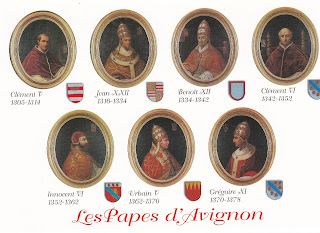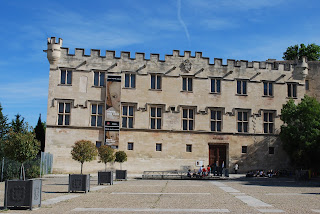The story begns with the bitter conflict between Boniface VIII, elected Pope in 1295, and Philip IV, the King of France (Philippe le Bel). Philip was concerned with centralising his power in France, whereas Boniface, an energetic and aggressive Pope, insisted that the Papacy was supreme over all earthly sovereigns. Afte Boniface excommuniated Philip, the King struck. His minister, William de Nogaret, arrested Boniface at his summer retreat at Anagni in September 1303, allegedly hitting him in the face. Boniface was soon rescued by his supporters, but he dieda month later.
After the brief pontificate of Benedict XI (1303-4) the conclave was deadlocked for almost a year before electing the Archbishop of Bordeaux, who took the name of Clement V. He never went to Rome, but moved around France before settling at Avignon; an insignificant town of just a few thousand inhabitants, but which had the benefit of being on the frontier between France and Provence. At that time the Count of Provence was a subject of the Holy Roman Emperor, not of the French King. The Popes were to remain there for 68 years; a period that came to be known as the "Babylonish Captivity".
Clement V proved to be a weak character, who failed to stand up to King Philip when the latter staged his brautal campaign to destroy the Knights Templar. It was said that when Jacques de Molay, the last Grand Master of the Temple, was burnt at the stake in Paris as a lapsed heretic in 1314, he denounced both King and Pope, prophesying that they would both die within the year - which in fact did happen.
There then followed a deadlocked conclave lasting two and a half years before the election of another Frenchman as Pope John XXII. He was already 68 years old, but proved to be full of energy. He bagan the building of the Palace of the Popes in Avignon, and was also responsible for the famous vineyard of Chateauneuf du Pape. His reign was followed by five more Popes resident at Avignon: Benedict XII, Clement VI, Innocent VI, Urban V and Gregory XI.
All were Frenchmen, and most were highly corrupt, practising rampant nepotism. The conclave was dominated by French cardinals. The Palace of the Popes grew to be the largest building of its kind in western Europe. Petrach visited Avignon, and was appalled and disgusted by the luxury he found there.
Urban V (1362-70) accepted the need to return the Papacy to Rome, and did indeed travel there, but soon gave up and went back to Avignon. Then Gregory XI (1370-8), following the importunities of Catherine of Siena, returned to Rome,intending to stay there, but soon died, aged only 48. The Italians then seized the initiative and elected as Pope Bartolomeo Prignano, a Neapolitan of humble birth, with a career as a bureaucrat in the Papal chancellery. He took the name of Urban VI.
But this was not the end of the story for Avignon. Pope Urban soon revealed paranoid, even psychopathic tendencies; torturing and executing cardinals whom he suspected of treachery. Within a few months a group of dissident cardinals fled back to Avignon and declared Pope Urban deposed. In his place they elected Robert of Geneva, a violent, aggressive aristocratic cardinal, as Clement VII. Now there were two rival Popes, one at Rome and one at Avignon, busy pronouncing anathema against each other and their supporters. The monarchs of Europe chose sides according to political convenience. This disgraceful episode, known as the "Great Schism", lasted into the next century. For a while there were even three rival Popes! It is no great surprise that early Protestant ideas, exemplified by Wyclif in England and Jan Hus in Prague, began to florish. The problem was not solved until the Council of Constance (1414-17), when the three rival Popes resigned or were deposed, Jan Hus was burnt at the stake (despite having received a safe-conduct from the Emperor Sigismund), and a Roman aristocrat, Oddone Colonna, was elected as Pope Martin V. The Popes never returned to Avignon.
But Avignon remained Papal territory. In 1348 Clement VI had purchased it outright from Queen Joanna of Naples (who also ruled Provence) for the paltry sum of 80,000 florins. This favourable purchase was probably not unconnected with the fact that Queen Joanna had come before the Papal court accused of murdering her husband. She was acquitted, but later deposed and killed in her turn.
While the Popes were in residence, it was a tolerant city (Jews were left in peace in return for paying a special tax), but it was also a haven for criminals fleeing justice from France. The lawless warbands who terrorised France during the Hundred Years' War were paid to stay away.
The Petit Palais, near the great palace, was remodelled in Renaissance style by Cardinal della Rovere, who later became Pope Julius II.
Provence was incorporated into France in the 15th century; but only with the French Revolution did Avignon become part of France. The Palace of the Popes was occupied and plundered and used as a barracks. No furniture survives, and of the lavsh decorations, only a couple of chapels and a few of the Popes' private rooms. But the days of glory were long past.
Is this the sort of luxury which so disgusted Petrach?
Tuesday, 3 July 2018
Subscribe to:
Post Comments (Atom)









No comments:
Post a Comment